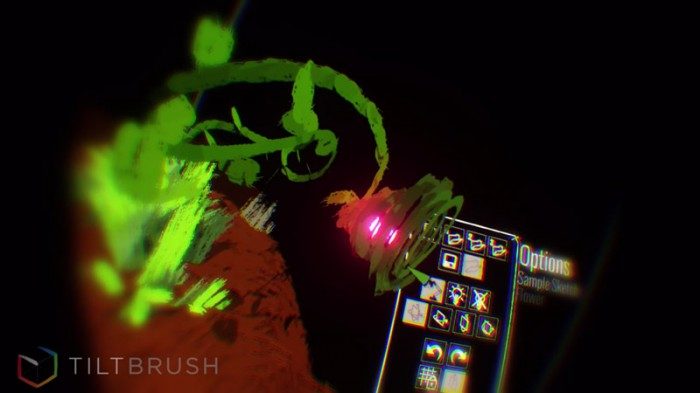A previously unknown virtual reality software title, Tilt Brush, went home with the Proto Award for Best GUI (graphical user interface) thanks to its innovative virtual reality interface. The software uses a gaze-based interface that allows users to paint in 3D and even use the Oculus Rift DK2’s positional tracking for brush input.
Tilt Brush was completely unknown prior to the Proto Awards, which had their first show last weekend in Hollywood, CA. When testing Tilt Brush as a judge for the Protos, it took me about 30 seconds inside the title before I understood exactly what was going on. Once I got it though, everything clicked.
Tilt Brush uses a powerful gaze-based interface which redefines the fidelity that can be achieved with menu-driven interaction in virtual reality. The title took home the Proto Award for Best GUI. I spoke with Patrick Hackett from Skillman & Hackett, the VR studio responsible for Tilt Brush, to learn more.
“I’ve been playing games my whole life and the recent boom of VR was something I had to chase,” said Hackett, who previously worked with his partner Drew Skillman at Double Fine Productions. “We started Skillman & Hackett in May of this year.”
Surprisingly, the Tilt Brush interface was an accident that Skillman stumbled upon while working on an AR prototype.
“He was building a chess board with fiducial markers, had to switch to using his Wacom tablet because his mouse was giving him troubles, accidentally had the cursor he was controlling emitting a line that didn’t disappear, and the light bulb went off,” Hackett told me. “He brought the chess board demo over to my house the next day and we decided to flesh the idea out for a week. A week turned in to three and now we’re here.”
In Tilt Brush, the user controls a 2D plane upon which paint is applied. The surface can be rotated and moved into any position, allowing the painting of shapes with depth. Users can even use their head as input: with the right keyboard modifier, users can move their head (taking advantage of the Oculus Rift DK2’s positional tracking, to escape the plane and drag their brush through 3D space—it’s surprisingly intuitive.
Several menus float around the user and when they are looked at they capture the cursor, allowing users to make high-fidelity menu selections using a mouse or digital drawing tablet.
“I would imagine that the ‘gaze-based’ GUI in Tilt Brush will be common for early VR applications of all kinds,” Hackett said. “It will certainly evolve as time goes on, but it’s such a satisfying way of organizing data, it’ll be something we stick with in the future.”
The results that come out of Tilt Brush are digital paintings with depth. In addition to paint, users can draw with light which illuminates the scene and can be used to beautiful effect.
The duo took home the award for Best GUI from the Protos, along with Nvidia’s new GeForce GTX 980 as a prize. Tilt Brush was nominated for the award among Darknet, Diplopia, Proton Pulse, RoboBliteration, and VR Typing Trainer.
See Also: Nvidia’s New Graphics Cards Are Designed for High Performance Virtual Reality Rendering
“We did not expect to win anything at the Proto Awards,” Hackett told me. “We were immensely honored to be nominated, considering what we were up against, and winning the first award at the first VR awards show was fantastic. That was a great show.”
Hackett wouldn’t give a precise release date for Tilt Brush, which has no publically available demo for now, but he says that the studio aims to release it prior to the Oculus Rift CV1 (consumer version).
“Tilt Brush is definitely getting a proper release. We’re very excited about where we can take it and encouraged by the reception it has received.”




